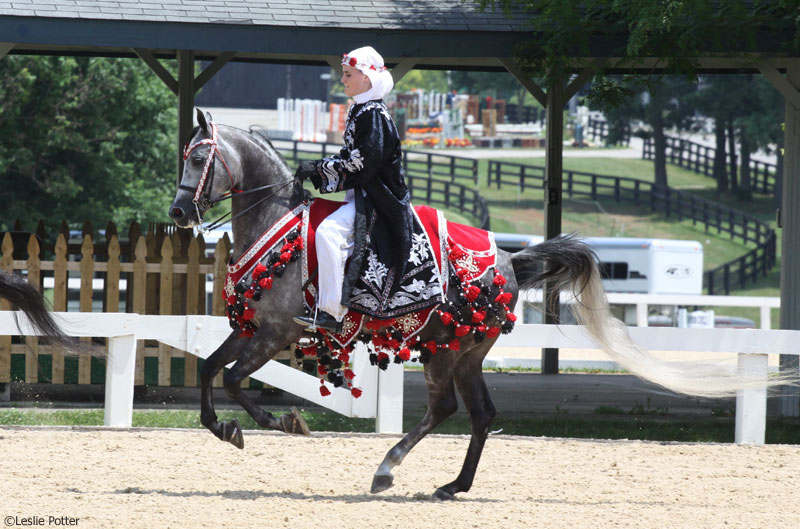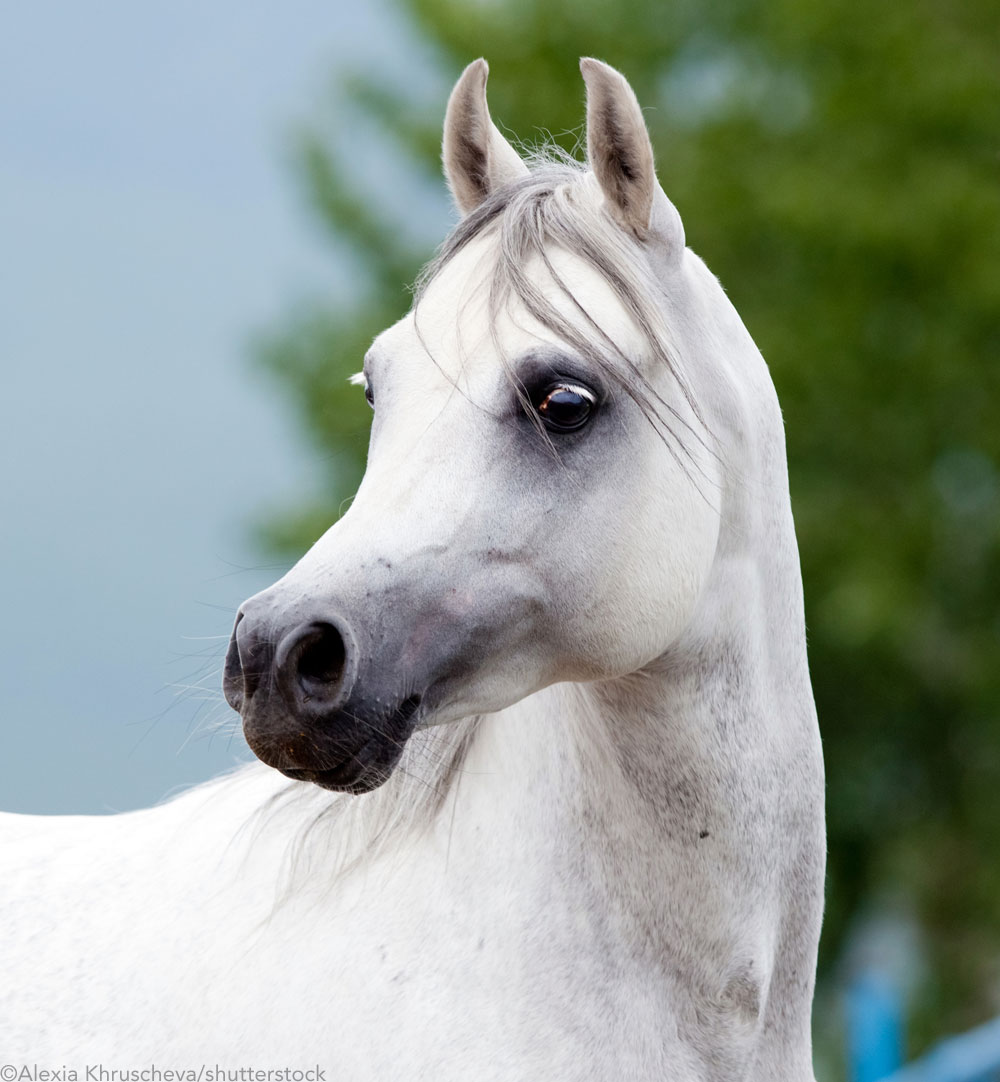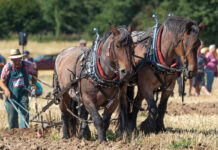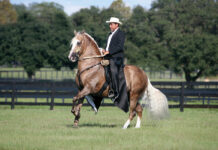The Arabian horse embodies the history of nations and the growth of cultures, and has had an impact on nearly every other horse breed in existence today. To look at the Arabian is to see more than the beauty of its expressive eyes, dished face and refined features. It is to realize the magnitude of the contribution this one breed has made to the horse industry and the world overall.

Deep History of the Arabian Horse
Perhaps the Arabian horse’s legendary history is part of what has contributed to its popularity.
“The Arabian horse was used as an ambassador and was often given as a treasured gift to royalty or important political figures,” says Susan Meyer, vice president at large of the Arabian Horse Association, vice president of the Arabian Jockey Club and a trustee of the Purebred Arabian Trust. She and her husband, Jim, have owned and operated Meyercrest Arabians in North Carolina for 39 years, and have owned, bred and shown horses to championships at the local, regional and national level. They have also owned, bred and raced purebred Arabians across the United States.
“Arabians were also prized as spoils of war, and many governments established purebred breeding programs of their own,” continues Meyer. “As a result, almost all Arabian pedigrees can be traced back to a horse that was part of a historical event or figure. This link with history is a fun and exciting part of owning an Arabian horse.”
Despite the Arabian horse’s long and alluring history, it’s incredible that the breed has remained so true to its original physical traits, and that it has been able to perpetuate those qualities for so long.
Although the specific area of the Arabian Peninsula where the breed originated can’t be pinpointed, it is widely accepted that around 2500 B.C., the Bedouin people were responsible for developing the desert horses that became the ancestors of the Arabian horse. The nomads’ keen horse sense and meticulous attention to proper care and breeding created an animal that could withstand the harsh environment of the desert, surviving extreme heat and cold with little water and the food they shared with their handlers. A life of travel also required horses with great lung capacity, endurance and stamina.
Fascinating Facts
Many of the Arabian’s characteristics have an ancient religious or superstitious belief attached to them. These traits were highly sought after and became the focus of the Bedouins’ selective breeding practices.
- Jibbah: The bulging forehead was considered a blessing from God. The Bedouins believed that the larger an Arabian’s forehead, the more blessings he brought with him.
- Mitbah: The area where the head attaches to the neck—behind the ears along the topline of the neck and the throatlatch. The Mitbah symbolized courage.
- The Arabian was also prized for a petite, refined muzzle that could “fit into a teacup.”
In addition to wealth and good luck, most of the Arabian’s traits have a significant physical benefit. For instance, the short, dished head and flaring nostrils promote optimum oxygen intake. Furthermore, the Mitbah’s long, fine characteristics prevent the windpipe from being constricted when the head is in a collected frame, which promotes the free flowing of oxygen to the lungs at all times. And the deep chest and wide ribcage permit lung expansion.
- The breed’s Arabian name “Kohl-ani” is a reference to its eyes and skin. The smooth skin is the color of Kohl, a bluish-black substance that was used in Egypt in ancient times as eyeliner and eye shadow.
- Mares were prized over stallions because they perpetuated the breed. They were also preferred for war because they wouldn’t nicker to the enemy’s mounts during raids. Mares were so valued that they were rarely sold. If they changed owners, it was considered a very honorable gift
“The Bedouins and their horses depended on each other for survival, and this interdependency created a very strong human-animal bond,” says Meyer. “Also, only the soundest, most trainable and hardiest individuals survived and bred on. The Bedouins recognized the importance of preserving the attributes that they depended on so much, and their selective breeding practices concentrated on the positive attributes of individual lines. Because of this concentration of blood, even today’s Arabians are able to consistently and predictably pass on their abilities to their offspring. This makes them highly prized as breeding animals.”
Cultural Influence
The Arabian’s physical traits and ability to pass them on to other horse breeds became a major force behind its appeal to other societies in history. About 3,500 years ago, the Arabian helped expand empires such as Egypt and shaped cultures by influencing the horses that were used to settle nations, fight wars and grow economies.
When Arabia worked to spread Islam in 600 A.D., the Arabian horse carried Arab warriors throughout the Middle East and as far as North Africa, Spain and China. Through this effort, and as a result of the expansive Christian Crusades during the 11th and 13th centuries, the Arabian horse began leaving its mark on European horses. It added refinement to heavier draft breeds and height to smaller ponies.
However, its greatest influence was likely that of developing the English Thoroughbred. Three stallions—the Godolphin Barb, Darley Arabian, and Byerly Turk—are credited with being the foundation sires of the Thoroughbred breed between the late 1600s and mid-1700s. Today, the majority of Thoroughbreds can be traced to one of these sires. In turn, the Thoroughbred added to the influence of the Arabian by passing on the traits it inherited from this ancient horse to many other breeds, particularly the American Quarter Horse.
“The Arabian has demonstrated a unique ability to consistently pass on its desirable traits,” says Meyer. “For centuries, nearly all light horse breeds and some draft and warmblood breeds have used the Arabian horse to develop or improve their breed. The Arabian’s ability to influence other breeds is well demonstrated by today’s Thoroughbred racehorses. Genetic testing has proven that 95 percent of all modern Thoroughbred racehorses trace to [one of these foundation] stallions. The mighty Secretariat traced to all three of the foundation stallions.”

Rise and Fall of the Arabian Horse in History
In the 1800s, influential Arabian stud farms were established all over Europe. The historic Crabbet Arabian Stud in England, founded by 15th Baroness Wentworth Lady Anne Blunt and her husband, Wilfred Blunt, produced horses that contributed to the spread of the Arabian breed to Russia, Poland, Australia, Egypt, and North and South America.
In the United States, Randolph Huntington started what is considered to be the first purebred Arabian horse breeding program in history, established in 1888. Later, 45 Arabian horses exhibited at the 1893 Chicago World’s Fair inspired further interest in the breed in America. This led to the formation of the first stud book and the Arabian Horse Club of America registry in 1908, now known as the Arabian Horse Association. Subsequent breeding farms and importations in the early and mid-1920s led to further growth of the breed in the United States. Davenport Arabians and Kellogg Ranch, which was established by cereal tycoon W.K. Kellogg, were two of the breeding farms that moved to the forefront of the industry at that time.
“In the late 1800s and early 1900s, several wealthy American entrepreneurs became enthralled with the history, beauty, athletic ability and unique human-animal bond that the Arabian horse represented,” says Meyer. “They began importing Arabian horses from the Middle East and Europe. These horses were not only used to cross with indigenous horses, but they were also used to establish herds of breeding stock to preserve a source of purebred Arabians here in the United States.
“In the 1960s, 70s and 80s, the large inventory of purebred Arabians that were the result of these breeding programs enabled the Arabian to become affordable for the average American family, and the same attributes that attracted the early breeders to the Arabian made them extremely attractive to American families,” continues Meyer. “During that time period, more than 30,000 purebred Arabian foals were born every year. These were unprecedented numbers that far exceeded any other country, and as a result, there are as many registered Arabian horses in the United States as nearly all other countries combined.”
An unfortunate result of this boom in the U.S. Arabian population was a severe downturn in its popularity during the 1980s. Changes in the economy and indiscriminate breeding gave rise to misconceptions that left reputable breeders and promoters disheartened and struggling to pick up the pieces.
“After the breed became extremely affordable, it was also embraced by many celebrities, and the most valued breeding stock and show horses sold for astronomical amounts,” says Meyer. “These were the horses with the highest profiles and the stories that were most often publicized, so the perception that Arabians are extremely expensive still persists. However, Arabian horses run the gamut of price ranges, and the vast majority of them are as affordable as any breed.”
Making a Comeback
A new focus in the 1990s on ability and promoting the Arabian as an all-around performer and family horse helped launch a resurgence for the breed after its rich history. Because of this, Arabian horse owners enjoy participating in various equestrian sports today, from reining to dressage. The breed particularly excels in endurance and trail riding.
“Many people in the modern dressage world value Arabian blood to bring lightness and suppleness to their horses,” says Meyer. “Even working western disciplines appreciate the endurance that Arabians can add to their horses that must work long hours over rough terrain. And in distance riding events, the Arabian is king. All of the major distance events are dominated by Arabians.”
The Arabian also continues to fight an enduring misconception about being high-strung, which has a lot to do with the breed’s past, says Meyer.
“The most prized horses of the Bedouins were the mares that were used in raiding other tribes,” explains Meyer. “A mare not only had to be unfailingly loyal to her master, but she also had to be fierce and courageous in battle. The uninformed can believe Arabians are naturally aggressive, when in fact, these traits are learned behaviors.
“The natural brilliance that the Arabian displays while at play has been emphasized in the show-ring in the halter division,” adds Meyer. “This learned behavior has only perpetuated the myth that the Arabian is flighty and nervous. This isn’t the way the Arabian deports itself day in and day out. The Arabian was the original family horse and is still an ideal horse for families today.”
A Bright Future
With so many qualities and rich history to admire about the Arabian horse and an exhibit such as the Arabian Galleries to promote it, the breed can look forward to maintaining its popularity in the horse community, according to Meyer.

“The same qualities that propelled the Arabian horse throughout the world are what ensure its longevity and continued popularity,” she explains. “The Arabian has proven that it has the ability to adapt and be successful. One horse can serve as a mount for [adults] and children in multiple disciplines. In today’s economy, with ever increasing pressures on space and the environment, the ability to serve multiple demands bodes well for the Arabian breed.”
Meyer believes two trends that have made their way into the Arabian horse industry will propel the breed into a successful future that will build upon its expansive history.
“Probably one of the most significant new trends has been the natural horsemanship approach to training,” says Meyer. “It’s especially suited to the Arabian personality. Arabians are naturally curious and interested in people, and particularly enjoy the interaction that is so important in this type of training. Arabians learn much faster and are easier to deal with using this approach versus other methods of training that depend more on negative reinforcement.”
Like most attributes about the Arabian horse, Meyer says this inclination toward natural horsemanship is linked to the breed’s past. “Because Arabians had to live among the Bedouin families, even residing in the tents with them at times, they had to be particularly docile and tractable,” explains Meyer. “The foals were weaned only a few days after birth and were raised by the women and children on camel’s milk and dates. The foals’ lives depended on their bond with humans, and over the centuries, the foals that had this affinity for connecting with humans have been the ones that bred on. The natural horsemanship methods allow this connection to develop to a very high level.”
Meyer says another trend that has secured the Arabian’s top position in the horse industry is the baby boomers’ growing interest in riding, and their desire for suitable mounts that are both athletic and reliable.
“The Arabian’s sensitivity and athletic abilities are particularly suited to the athletic challenges that the mature rider deals with, particularly in competitive disciplines,” says Meyer. “The strength and stamina of the rider is not as crucial when riding Arabians, as they are so easy to collect and maneuver.”
With an appeal that has drawn people of so many different backgrounds to the Arabian horse over the ages, the breed is sure to continue its influential role for a long time
to come.
Part II: A Fitting Tribute to the Arabian Horse >>
The Enduring Arabian >>
Question of the Week: Skinny Lesson Horse>>
This article about the history of the Arabian horse originally appeared in the January 2011 issue of Horse Illustrated. Click here to subscribe.






I wish I had one.
I’ve wanted a white (gray) Arabian mare for 10 years!